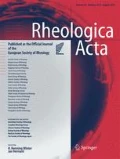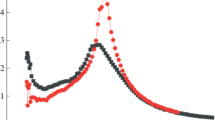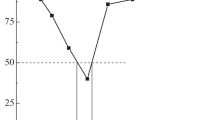Summary
Sodium carboxymethylcellulose (CMC) is a valuable and widely used component of food systems. The rheological properties of a series of CMC solutions and gels have been determined under both steady and imposed sinusoidal shear conditions, over a wide range of shear rates and frequencies, using theWeissenberg Rheogoniometer. Depending upon the CMC type, degree of substitution, and method of solution preparation, the rheological behavior ranged from viscolastic solutions to unctuous gels. If certain polyvalent cations, e.g., Al3+, are present, rigid elastic gels may be formed.
These results are interpreted in terms of fringe micelles, arising from crystalline residues in the CMC. Gels which show unctuous behavior may be described in terms of a modifiedBingham Body model. Where appropriate, the experimental results are quantitatively analyzed in terms of the parameters of this model. The application of these findings to the use of CMC in food systems is discussed.
Similar content being viewed by others
References
Hercules Incorporated “Chemical and Physical Properties of Hercules Cellulose Gum (CMC), Wilmington, Delaware, 1971.
Ganz, A. J., Some Observations on the Interaction of Sodium Carboxymethylcellulose with Proteins. Presented at IFT Annual Meeting, 1972.
Ott, Emil andH. M. Spurlin, Cellulose and Cellulose Derivatives, 2nd Ed., p. 937ff. (Interscience, New York 1954).
Francis, P. S., J. Applied Polymer Sci.5, 261 (1961).
Smith, J. W. andP. D. Applegate, Paper Trade J.126, 60 (June 3, 1948).
Green, H., Industrial Rheology and Rheological Structures (Wiley, New York 1949).
Ott, Emil andJ. H. Elliott, Makromol. Chem.18/19, 352 (1956).
De Butts, E. H., J. A. Hudy andJ. H. Elliot I. E. Chem.49, 94 (1957).
Ferry, J. D., Viscoelastic Properties of Polymers, 2nd Ed. (Wiley, New York 1970).
Elliot, J. H. andA. J. Ganz J. Texture Studies2, 220 (1971).
Elliot, J. H. andC. E. Green J. Texture Studies3, 194 (1972).
Trapeznikov, A. A. Proceedings of the Fifth International Congress on Rheology.S. Onogi (ed.), Vol.4, p. 257 (Univ. of Tokyo Press, Tokyo 1970).
Ganz, A. J. Food Product Develop.3 (6, 65 (1969).
Batdorf, J. B. in:R. L. Whistler (Ed.), Industrial Gums (Academic Press, New York 1959).
Nijhoff, G. J. J., U.S. Patent 3,418,133.
Glicksman, M., Gum Technology in the Food Industry (Academic Press, New York 1969).
Author information
Authors and Affiliations
Additional information
Hercules Research Center Contribution No. 1600
With 7 figures and 1 table
Rights and permissions
About this article
Cite this article
Elliot, J.H., Ganz, A.J. Some rheological properties of sodium carboxymethylcellulose solutions and gels. Rheol Acta 13, 670–674 (1974). https://doi.org/10.1007/BF01527058
Issue Date:
DOI: https://doi.org/10.1007/BF01527058




